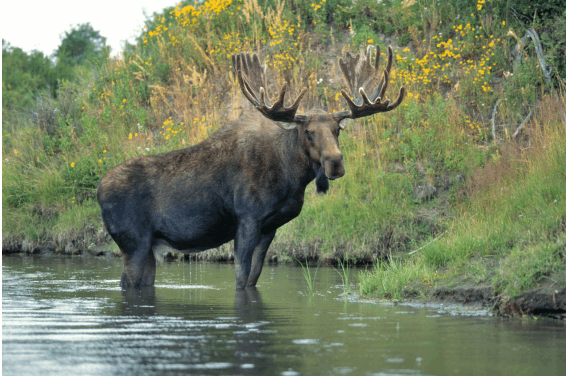カナダ出身の英語ネイティブの翻訳者から、ムース(ヘラジカ)ついて話を聞きました。
2021年1月27日 14時46分
※英語原文は日本語記事の下に掲載しています。
ムースは、シカ科最大の動物で、その覆いかぶさるような上唇、
胸垂として知られる喉のあたりの肉垂、非常に大きな枝角など、
際立った特徴で知られています。
広くカナダのシンボルと考えられているヘラジカですが、
4亜種がカナダの広範囲に分布していることが分かっています。
ムースの外皮は、季節によって茶褐色から灰色がかった色に変化します。
肩高は1.5~2mほどあり、成獣になると体重は500~750㎏にもなることもあります。
ムースは、落葉樹林でも針葉樹林でも見られ、
冬の氷が溶けると、湖、川、湿地の周辺に集まります。
ムースの長い脚と広い蹄は、障害物を取り除き、
柔らかい雪やぬかるんだ地面で足場を保つのに役立ちます。
彼らの脚は、短距離であれば時速55kmにまで達することができます。
また驚くほど力強い泳ぎ手で、水生植物を探して完全に水に潜ることもできます。
ムースは通常、高く伸びる植物を食べることを好みますが、
冬は、雪面の下にある苔や地衣類を食べて生きています。
雌のムースはcow(雌の牛やヘラジカ)、
雄のムースはbull(雄の牛やヘラジカ)と呼ばれています。
雄のヘラジカだけに枝角が生え、それは毎年11月頃に落ちます。
4月にはまたそれが生えてきて、秋の交尾の季節までに完全に生え代わります。
雄のヘラジカは、枝角を使って、実際にとっくみ合いをしたり、
単に見せかけのポーズを取ったり誇示したりして、雌をめぐって他の雄と争います。
雌のヘラジカは、春に15㎏ほど体重がある子供を1~2頭を産みます。
子どものヘラジカは、次の出産シーズンに間に合うように、
およそ6ヶ月後に乳離れします。

ムースはカナダのシンボルである動物の1つです。

ムースは、普通の鹿よりもはるかに大きく、車のドライバーに危険を及ぼすこともあります。雄のムースは、とても攻撃的になる発情期(9月~10月)には人間を襲うことでも知られています。
~編集後記~
ムースを見たことはありませんが、写真に写っている車と比較すると、その大きさがよく分かりますね。実際に目の当たりにしたら、きっととても迫力があると思います。
ムースは、シカ科最大の動物で、その覆いかぶさるような上唇、
胸垂として知られる喉のあたりの肉垂、非常に大きな枝角など、
際立った特徴で知られています。
広くカナダのシンボルと考えられているヘラジカですが、
4亜種がカナダの広範囲に分布していることが分かっています。
ムースの外皮は、季節によって茶褐色から灰色がかった色に変化します。
肩高は1.5~2mほどあり、成獣になると体重は500~750㎏にもなることもあります。
ムースは、落葉樹林でも針葉樹林でも見られ、
冬の氷が溶けると、湖、川、湿地の周辺に集まります。
ムースの長い脚と広い蹄は、障害物を取り除き、
柔らかい雪やぬかるんだ地面で足場を保つのに役立ちます。
彼らの脚は、短距離であれば時速55kmにまで達することができます。
また驚くほど力強い泳ぎ手で、水生植物を探して完全に水に潜ることもできます。
ムースは通常、高く伸びる植物を食べることを好みますが、
冬は、雪面の下にある苔や地衣類を食べて生きています。
雌のムースはcow(雌の牛やヘラジカ)、
雄のムースはbull(雄の牛やヘラジカ)と呼ばれています。
雄のヘラジカだけに枝角が生え、それは毎年11月頃に落ちます。
4月にはまたそれが生えてきて、秋の交尾の季節までに完全に生え代わります。
雄のヘラジカは、枝角を使って、実際にとっくみ合いをしたり、
単に見せかけのポーズを取ったり誇示したりして、雌をめぐって他の雄と争います。
雌のヘラジカは、春に15㎏ほど体重がある子供を1~2頭を産みます。
子どものヘラジカは、次の出産シーズンに間に合うように、
およそ6ヶ月後に乳離れします。

ムースはカナダのシンボルである動物の1つです。

ムースは、普通の鹿よりもはるかに大きく、車のドライバーに危険を及ぼすこともあります。雄のムースは、とても攻撃的になる発情期(9月~10月)には人間を襲うことでも知られています。
~編集後記~
ムースを見たことはありませんが、写真に写っている車と比較すると、その大きさがよく分かりますね。実際に目の当たりにしたら、きっととても迫力があると思います。
~編集後記~
ムースを見たことはありませんが、写真に写っている車と比較すると、その大きさがよく分かりますね。実際に目の当たりにしたら、きっととても迫力があると思います。
(英語原文)
The Canadian Moose
The moose is the largest member of the deer family, and is known for its distinct features, such as its overhanging upper lip, throat flap known as a dewlap, and enormous antlers. Commonly considered to be a national symbol, four subspecies are found widely distributed across Canada.
Moose coats vary from dark brown to grayish depending on the season. They stand at 1.5 to 2 meters tall at the shoulder, and can weigh anything from 500 to 750 kilograms fully matured. Moose are found in both deciduous and coniferous forests, and once the winter ice melts, around lakes, rivers, and wetlands. Their long legs and wide hooves help moose clear obstacles and retain their footing in soft snow or on muddy ground. They can reach speeds of up to 55 km/h over short distances, and are also surprisingly strong swimmers, even going completely underwater in search of aquatic plants. Moose generally prefer to browse on plants that are higher, but in winter will subsist on mosses and lichens found beneath the snow.
Female moose are called cows, and male moose bulls. Only bulls grow antlers, and shed them every year around November. They begin growing back in April, and are fully recovered in time for the mating season in fall. Bulls use their antlers to compete with other bulls for cows, either by actually locking antlers or simply posturing and displaying. Cows give birth to 1-2 calves in the spring, each weighing around 15 kilograms. Calves are weaned after about 6 months, in time for the next breeding season.
(写真上記)
The moose is one animal that symbolizes Canada.
(写真上記)
Moose are much larger than regular deer and can pose a danger to drivers. Bull moose are also known to attack humans during their rutting season (Sep-Oct), when they become overly aggressive.
The moose is the largest member of the deer family, and is known for its distinct features, such as its overhanging upper lip, throat flap known as a dewlap, and enormous antlers. Commonly considered to be a national symbol, four subspecies are found widely distributed across Canada.
Moose coats vary from dark brown to grayish depending on the season. They stand at 1.5 to 2 meters tall at the shoulder, and can weigh anything from 500 to 750 kilograms fully matured. Moose are found in both deciduous and coniferous forests, and once the winter ice melts, around lakes, rivers, and wetlands. Their long legs and wide hooves help moose clear obstacles and retain their footing in soft snow or on muddy ground. They can reach speeds of up to 55 km/h over short distances, and are also surprisingly strong swimmers, even going completely underwater in search of aquatic plants. Moose generally prefer to browse on plants that are higher, but in winter will subsist on mosses and lichens found beneath the snow.
Female moose are called cows, and male moose bulls. Only bulls grow antlers, and shed them every year around November. They begin growing back in April, and are fully recovered in time for the mating season in fall. Bulls use their antlers to compete with other bulls for cows, either by actually locking antlers or simply posturing and displaying. Cows give birth to 1-2 calves in the spring, each weighing around 15 kilograms. Calves are weaned after about 6 months, in time for the next breeding season.
(写真上記)
The moose is one animal that symbolizes Canada.
(写真上記)
Moose are much larger than regular deer and can pose a danger to drivers. Bull moose are also known to attack humans during their rutting season (Sep-Oct), when they become overly aggressive.



